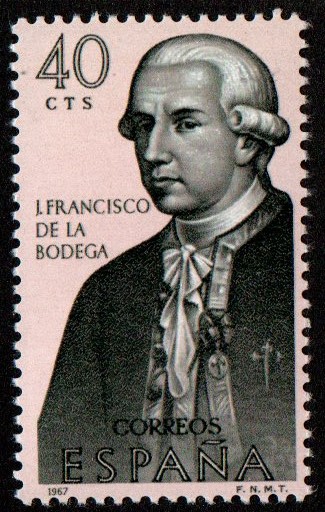Juan Francisco de la Bodega y Quadra was a Spanish naval officer and explorer who played a significant role in the exploration of the Pacific Northwest during the late 18th century. He was born in 1743 in Lima, Peru, which was then part of the Spanish Empire.
Bodega y Quadra is best known for his exploration of the Pacific coast of North America, particularly in the areas around present-day California, Oregon, and British Columbia. In 1775, he led an expedition to the region, exploring and mapping the coastline as part of Spain’s efforts to expand its influence in the Pacific.
Spain. 1967. Explorers and Colonizers of America (7th Series).
J. Francisco de la Bodega y Quadra.
0.40 pt. SG* 1877. MNH
6 million copies issued
Bodega Bay, located in Northern California, is named after Juan Francisco de la Bodega y Quadra. During his expedition, he sailed into the bay in 1775 and conducted detailed surveys and cartography of the area. The bay was later named in his honor to commemorate his contributions to the exploration of the region.

In 1789, Bodega y Quadra was involved in a pivotal event in the history of the Pacific Northwest. He was the commanding officer of the Spanish vessel “Princesa” when it encountered British Captain James Colnett’s ship “Argonaut” near Nutka Bay, which is now known as Nootka Sound in Vancouver Island, British Columbia, Canada.
The encounter between the Spanish and British ships at Nutka Bay led to a tense standoff, known as the Nootka Crisis. It was a diplomatic dispute over territorial claims and trading rights in the region. However, both Bodega y Quadra and Colnett acted with restraint, and ultimately a peaceful resolution was reached between Spain and Britain through negotiations.
The Nootka Crisis was significant because it led to the signing of the Nootka Convention in 1790, a treaty between Spain and Britain that aimed to prevent further conflicts in the Pacific Northwest. The treaty acknowledged the rights of both Spain and Britain to explore and trade in the region, contributing to a more peaceful coexistence between the European powers in the area.
Juan Francisco de la Bodega y Quadra’s explorations and diplomatic efforts helped to expand Spain’s knowledge of the Pacific Northwest and paved the way for further exploration and colonization in the region. His name and legacy are forever linked to the geographical landmarks of Bodega Bay and the historical events at Nutka Bay, now part of the rich history of the Pacific Northwest.
In 1967, Spain issued a postage stamp dedicated to Juan Francisco de la Bodega y Quadra, the Spanish naval officer and explorer who played a significant role in the exploration of the Pacific Northwest.
The stamp featured an illustration of Bodega y Quadra, commemorating his contributions to the exploration of the Pacific coast of North America during the late 18th century. The design might have depicted him in his naval uniform or during one of his expeditions, symbolizing his important role in Spain’s efforts to expand its influence in the Pacific region.
By issuing the postage stamp in his honor, Spain recognized the historical significance of Bodega y Quadra’s explorations and the diplomatic efforts that led to the peaceful resolution of the Nootka Crisis at Nutka Bay (Nootka Sound). The stamp served as a tribute to his important contributions to Spanish exploration and his role in promoting peaceful relations between European powers in the Pacific Northwest.
#SpainPostageStamp, #BodegaYQuadraStamp, #1967Stamp, #SpanishExplorer, #PacificNorthwestExploration, #NootkaCrisis, #ExplorationHistory, #SpanishHistory, #PacificCoastExploration, #NavalOfficer, #SpanishExplorers, #PacificNorthwest, #NootkaSound, #BodegaYQuadraLegacy, #HistoricalTribute, #StampCollectors, #Philately, #SpainHistory, #PacificExploration, #NauticalExplorations, #NauticalHistory, #ExplorationCommemoration, #PacificNorthwestHistory.

